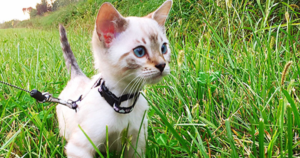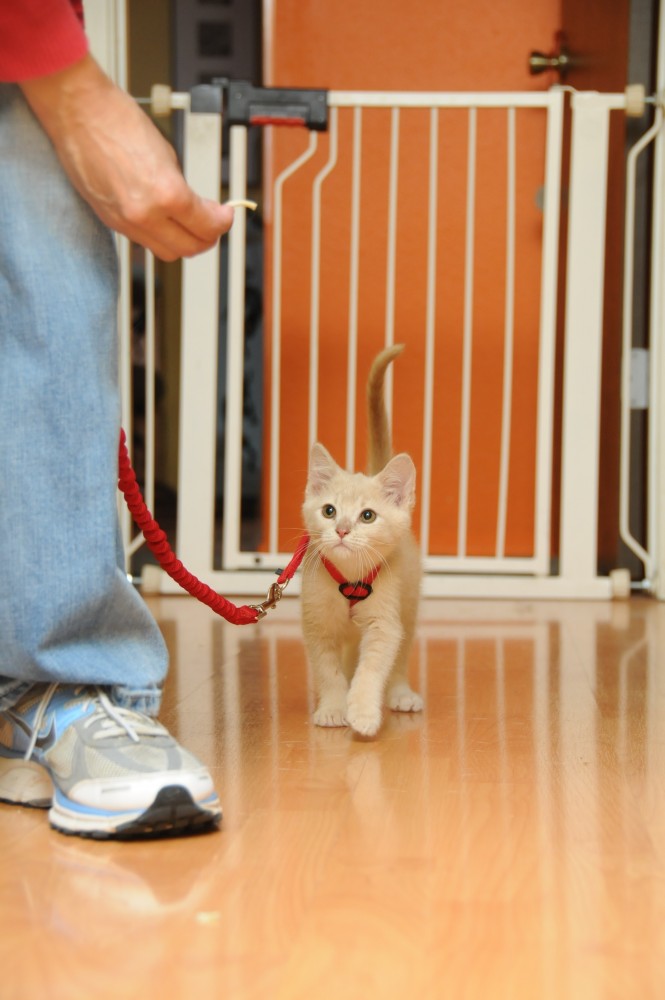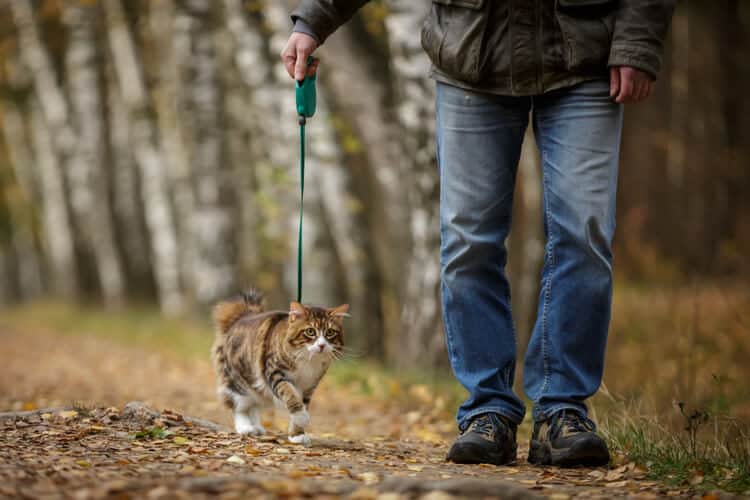Harnessing your cat
It's perfectly possible to gradually get your cat to like going out on a lead. It's a question of proceeding gently to gradually get him used to it.
If you want to take your cat out safely, a lead and harness are the ideal solution. Although kittens usually tolerate them well, it's not always easy with adult cats. You'll need to gradually get used to the lead and harness.
Many cats are city dwellers and live in flats. Even if it is possible to make them happy by enriching their environment (cat trees, scratching posts, observation posts, lots of games, etc.), cats always enjoy going outside. The outside environment is much more stimulating for them.
Taking your cat out on a lead should only be considered if you are able to do so in a safe environment. quiet, secure location. If the place is too noisy, if there are lots of cars, people or dogs, then it's likely to stress your cat enormously. It's important to remember that cats are by nature very reactive. fearfulThey are seen as prey by many dogs, and going out can quickly become a nightmare. stressful for them. Especially if you take him out on a lead, as he won't be able to run away and hide freely.
Sometimes owners prefer to take their cats out on a lead even if they live in a house, if they live next to a busy road for example. It can also be useful to tie your cat up when travelling by car, to allow it to get out of its carrier in complete safety during breaks.
It's important to choose the right harness: you need to measure your neck and chest size carefully so that you can choosing the right size and prevent your cat from removing the harness if it panics.
Getting them used to it from an early age
As with any educational principle, it's always much easier to instil rules and habits in a kitten than in an adult cat. So, if you've just adopted a small cat or are planning to do so, it's never too early to start harnessing it. An adult cat can be more temperamental and may not accept anything new, so don't wait too long before putting it on!

Putting the harness on inside the house

The outside world is full of noises, smells and, above all, other four-legged companions, so throwing your cat straight into the deep end of the outdoor pool can be stressful or even traumatic.
That's why it's a good idea to get him used to the harness indoors.
Go gradually: put it on him for a few seconds to see how he reacts. If he tolerates it without any problems, get him used to wearing it for a little longer every day until he doesn't notice it any more. If, on the other hand, he doesn't seem to appreciate the experience, just let him wear it for a few seconds, then try again the next day. Gradually, it should be possible to make him wear it for longer and longer, a few minutes, an hour, until the day comes when he accepts it completely.
Contrary to popular belief, cats can be trained in the same way as dogs. So it's important to praise your cat throughout the various stages of its training. To do this, don't hesitate to stroke it and talk to it when you put it in its harness and it doesn't react badly.
You can also give him a treat when you put the harness on, to help him make the connection between the two. This will help him understand what you want from him.
Allow them a degree of independence

Once you've managed to get through these stages and your cat is comfortable walking around in a harness, don't be too prescriptive with your cat. Whether indoors to start with, or outdoors if the time comes, let him sniff out his new environment and adapt to outside noises and smells. Don't pull too hard on the harness and let your cat take control of his movements. That's how he'll gain confidence, not by being guided too much.
When you feel he's ready and comfortable, you can take your cat to new places where he can run around and let off steam. There's no shortage of choice: parks, forests, public gardens... Choose places that are open, calm and where there's enough space so that your cat isn't too often confronted by other animals. Bear in mind that cats are often not very adventurous and are not always ready to make friends with other animals.
Sources :
Dr Bénédicte Hivin, veterinary surgeon with a diploma from the National Veterinary School in Lyon, I am a veterinary consultant at Wanimo. .
Marion Ruffié, Cat behaviourist / Author-Speaker-Media Consultant / Founder of absolumentchats.com
Website zoomalia.com
Interested in adopting a Siberian kitten?
Come and see if we have any kittens available at the moment.
